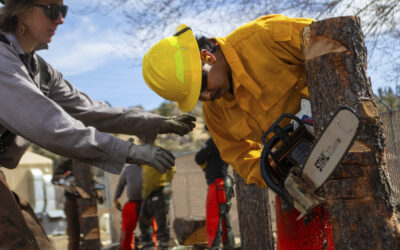Every year, thousands of people protect our country by working to suppress and control wildfires. Firefighters at the point of attack, pilots who drop fire retardant and the people who transport and deliver fire retardants to remote locations. Together, these people keep us safe, and it’s the fire safety industry’s responsibility to ensure their safety.
Right now, there’s a potential threat to that safety. A magnesium chloride-based aerial fire retardant was recently added to the US Forest Service Qualified Products List (QPL). The retardant was added to the QPL by the US Forest Service despite numerous reports on the damaging effects of using magnesium chloride – to aircraft, people and the environment. Before magnesium chloride is widely used on federal and state lands, it’s important to know the facts.
Magnesium Chloride and Aircraft
Chlorides are widely known to be exceptionally corrosive materials. They were first used by the state of New Hampshire to deice roads back in 1938, and due to their low cost and effectiveness they were quickly adopted across the country as a solution to icy and slippery roads. Today, it is estimated that each year 20 million tons of salt are used as a deicing agent.1
With its wide use, several organizations have looked into the impact these salts have on aircraft, and according to the Engineers Guide to Corrosion – Causes, Protection and Control, the lead components on an aircraft are susceptible to severe corrosion from exposure to magnesium chloride. Among a number of other chemicals listed in the Guide, the only other one identified to cause severe corrosion was nitric acid.2

Fire management agencies have used phosphate-based retardants successfully since 1963, and independent testing has proven it to be more effective than any other solution available, including magnesium chloride.
In 2000, the Environmental Protection Agency (EPA) conducted a study on approximately 200 airports around the country that had the potential for significant deicing operations to determine what impact the deicing materials that were widely in use (sodium chloride, potassium chloride and magnesium chloride) had on aircraft and the area surrounding the airport. As a result of the EPA’s research, the Agency continues to ban the use of magnesium chloride as a deicing agent in and around aircraft. In its report, the EPA stated, “Salts, including magnesium chloride … are not approved for use in aircraft operational areas because they are corrosive to aircraft.”3
EPA isn’t the only agency to put restrictions in place when it comes to the use of magnesium chloride around aircraft. In 2016, the Federal Aviation Administration (FAA) issued an advisory to all airports in the country on the use of chlorides as deicing agents, saying, “These chemicals are known to be corrosive to aircraft and therefore are prohibited for use on aircraft operational areas.”4
Corrosion and the reduced structural integrity of aircraft is an economic burden and affects operational capacity, but more importantly it is a safety issue. The presence of corrosion can lead to loss of structural integrity and potentially catastrophic failure, according to the Civil Aviation Authority.5 Fire retardant that is loaded on an airplane will, at some point, come into contact with almost every part of that plane, especially metal surfaces – like aluminum alloys – which are most susceptible to corrosion. With an exceptionally corrosive material, the potential for aircraft failure – particularly under the aggressive operational environment experienced during wildfire fighting – is an issue that should be well understood.
Magnesium Chloride’s impact on Infrastructure
In addition to aircraft, the corrosive properties of magnesium chloride also present a danger to the nation’s infrastructure. After observing that the service lives of some roads within the state were less than 10 years, the Iowa Department of Transportation funded research to investigate what role expansive minerals, such as magnesium chloride, played in their premature deterioration. Researchers found that, “In our experiments, the magnesium component of deicer salts proved to be the most deleterious [compared with sodium chloride and calcium chloride],’ and they concluded, “experiments with different potential deicers and Na-sulfate document that all of these chemicals cause concrete deterioration. Magnesium solutions are especially damaging and … decrease service life of concrete.”6
Meanwhile, South Dakota was facing similar challenges with their roads and commissioned a study from the Michigan Tech Transportation Institute. Researchers noted that the effectiveness of chlorides as deicing agents is clearly demonstrated, but determined that magnesium chloride chemically interacts with cement paste used in concrete, “resulting in expansive cracking, increased permeability, and a significant loss in compressive strength.”7
Once magnesium chloride leaches from roads, homes are not immune to its effects. In addition to being used as a deicer, magnesium chloride is sometimes applied on dirt roads to control dust. The magnesium chloride from these applications enters domestic water systems through aquifers and public water systems, and once it enters household water, it is highly corrosive to copper and stainless steel. “It rapidly corrodes the copper lines, fixtures, and stainless steel found in most appliances,” says Paul Hurlburt with Professional Water Systems, Inc.8
Magnesium Chloride and Vegetation
The two nutrients that comprise magnesium chloride are required for plant growth, so you may assume that spreading it on vegetation would be helpful, however, numerous studies on the effect of magnesium chloride point to negative effects.
Excessive amounts of magnesium chloride in the soil may reduce a plant’s ability to absorb calcium and other needed nutrients. It is also soluble in water and can exchange with heavy metals in soils, potentially releasing them into the environment, a concern that was raised in a report from Public Sector Consultants in 1993.9
Colorado State University conducted research and reported that once magnesium chloride enters a tree’s water-conducting system, it accumulates in the margins of leaves or needles. The leaves are weakened or killed, which can potentially lead to the death of the tree. According to the researchers, even low applications of mag chloride on roadsides can grow in concentration in roadside ditches, move off road into drainage areas and have a similar effect.10
Magnesium Chloride and Aquatic Life
When battling wildfires, retardant is applied on forests, and could potentially enter waterways. The US Forest Service has to trust that the product they are using is safe for the environment, and with magnesium chloride’s track record with aquatic life, using it as a fire retardant could present unnecessary challenges.
Even at low levels, the Missouri Department of Natural Resources says that chloride can negatively affect aquatic life structure, diversity and productivity. When levels are high, it says chloride is toxic to fish, aquatic organisms and amphibians.11
Researching the use of magnesium chloride on roadways, Colorado State University and Colorado Parks & Wildlife found that its runoff can ultimately have a detrimental impact on benthic macroinvertebrates, significantly reducing their abundance, taxa richness and community biomass.12 Negative impacts were even measured at levels of exposure considerably lower than the EPA criteria for chloride. This is important because aquatic macroinvertebrates are an important food source for fish, amphibians and other wildlife.
The negative impacts on aquatic life are even more disturbing given the findings from a 2014 United States Geological Survey that found that 84% of the urban streams they studies had rising chloride levels, and that 29% had already exceeded federal safety guidelines for at least part of the year.13 Once chloride enters a waterway, there isn’t a biological process that will help remove it. That means the effects of magnesium chloride are accumulative and using it as a fire retardant—with millions of gallons of it potentially being dropped on forests annually—will only add to what is already becoming a significant challenge.
Magnesium Chloride as a Fire Retardant
The aforementioned negative effects that magnesium chloride can have on aircraft, infrastructure, vegetation and aquatic life introduce enough uncertainty for its use to battle wildfire, but there is also more than 80 years of research that have found it to not be suitable as a fire retardant.
In 1940, research was conducted at the University of Idaho that studied the effectiveness of eight different chemicals as a fire retardant. Here are the chemicals they tested listed in order from most effective to the least effective:
- Diammonium phosphate
- Borax
- Monoammonium Phosphate
- Zinc Chloride
- Ammonium Sulphate
- Ammonium Chloride
- Magnesium chloride
Describing the results, the researchers concluded that, “magnesium chloride is not suitable as a fire retardant.” Meanwhile, diammonium phosphate performed the best.14
The first major study to look at fire retardant effectiveness, Operation Firestop, was organized by the US Forest Service in 1954. The study covered many of the chemicals that had been in use over the previous decades in firefighting products, including monoammonium phosphate, sodium silicate, ammonium chloride, magnesium chloride and boric acid.15 Phosphate was again among the most effective in reducing the impact of fire, while boric acid and magnesium chloride were among the worst.16 Following Operation Firestop, phosphate-based fire retardant became the industry standard for decades to come.
A subsequent study was conducted in 1970 by University of Montana Scientist Aylmer D. Blakely, who developed a new system for evaluating the fire retarding ability of chemicals to give reliable and easily interpretable information that he called the Superiority Factory Method. It was based on fuel weight loss, the amount of radiation emitted and the amount of residue after all combustion had ended as the fuel burned. While phosphate-based chemistries finished in first and second place, magnesium chloride was ranked as the tenth most effective.17
Human Safety
While magnesium chloride has never been deployed on a broad scale in wildfire suppression operations, recent laboratory scale tests comparing the effectiveness of phosphate-based fire retardant against a magnesium chloride-based solution showed that the magnesium chloride material requires nearly two times the amount to offer comparable performance to phosphate-based retardants.
The need to add twice as much magnesium chloride has significant ramifications on wildland firefighting. The weight of each load of retardant is higher, meaning that pilots would have to carry smaller loads. This would take pilots away from the fight more often to reload, giving fuels more time to feed the flames and create larger fires. At the same time, more fire retardant would be required to suppress the fire, increasing the amount of overall retardant aircraft are exposed to while fighting wildfires. As noted, magnesium chloride is inherently corrosive, and having to carry additional retardant presents an unneeded threat to the structural integrity of aircraft, introducing an additional danger to pilots.
In addition, Magnesium Chloride has been shown to cause skin irritation and chemical burns on people exposed to the chemical. Given that wildland firefighters routinely work around fire retardant, use of these products can expose firefighters to health and safety risks.
It is critical that we equip firefighters with the best tools available to ensure their safety and the safety of the people they are risking their lives to protect. Fire management agencies have used phosphate-based retardants to successfully battle wildfires for nearly 60 years, and independent testing has proven it to be more effective than any other solution available, including magnesium chloride. With all of the concerns around the use of magnesium chloride outlined in this article, the question must be asked if it is worth the risk to start using it as a fire retardant to protect property and save lives.
1 Hinsdale, Jeremy, “How Road Salt Harms the Environment, Columbia Climate School, 11 December 2018 https://news.climate.columbia.edu/2018/12/11/road-salt-harms-environment/, Accessed 7 November 2022
2 “Engineer’s Guide to Corrosion—Causes, Protection and Control”, Ezekiel Enterprises, LLC, pg. 117, https://cdn.ez-pdh.com/course-material/ME1112-Engineers-Guide-to-Corrosion-Causes-Protection-and-Control.pdf#page=117 Accessed 7 November 2022
3 “Preliminary Data Summary, Airport Deicing Operations (Revised),” Environmental Protection Agency, pg. 210, August 2022, https://www.epa.gov/sites/default/files/2015-06/documents/airport-deicing-pds-2000.pdf#page=210, Accessed 7 November 2022
4 ”Advisory Circular: Airport Field Condition Assessments and Winter Operations Safety”, Federal Aviation Administration, pg. 49, 29 July 2016, https://www.faa.gov/documentlibrary/media/advisory_circular/150-5200-30d.pdf#page=49, Accessed 7 November 2022
5“Corrosion and Inspection of General Aviation Aircraft,” Civil Aviation Authority, p. 6 July 2017, https://publicapps.caa.co.uk/docs/33/CAP1570_Corrosion.pdf#page=6, Accessed 8 November 2022.
6 Lee, Hyomin, et al. “PCC Pavement Deterioration and Expansive Mineral Growth,” 1998 Transportation Conference Proceedings, https://eco-solutions.net/wp-content/uploads/2019/04/pcc-pavement-deterioration-and-expansive-mineral-growth.pdf, Accessed 8 November 2022.
7 Sutter, Lawrence, et al., “The Deleterious Chemical Effects of Concentrated Deicing Solutions on Portland Cement Concrete,” p. 4, April 2008, https://pages.mtu.edu/~llsutter/SD_Final/pdf/FINAL_SD2002-01_Literature_Review.pdf#page=3, Accessed 8 November 2022.
8 “Find Out How Ice/Snowmelt Effects the Plumbing in Your House,” Smart. Healthy. Green. Living, 30 October 2020, https://shgliving.com/inspirations/green/find-out-how-ice-snowmelt-can-effect-the-plumbing-in-your-house/, Accessed 8 November 2022.
9 “The Growing Case Against Magnesium Chloride,” Eco Solutions, https://eco-solutions.net/the-growing-case-against-magnesium-chloride, Accessed 9 November 2022
10 “Magnesium Toxicity in Trees,” Colorado State University, United States Department of Agriculture, p. 1, Revised December 2014, https://extension.colostate.edu/docs/pubs/garden/07425.pdf, Accessed 9 November 2022
11 “Chloride,” Missouri Department of Natural Resources, https://dnr.mo.gov/water/hows-water/pollutants-sources/chloride#:~:text=High%20amounts%20of%20chloride%20are,change%20the%20plant%20community%20structure, Accessed 9 November 2022
12 Kotalik, Christopher J., et al., “Effects of Magnesium Chloride Road Deicer on Montane Stream Benthic Communities,” p. 1, 26 April 2017, https://www.uppermissouriwaterkeeper.org/wp-content/uploads/2021/02/Katalik-et-al.-2017-Effects-of-magnesium-choloride-road-deiver-on-montane-stream-benthic-communities.pdf, Accessed 9 November 2022
13 “Urban Stream Contamination Increasing Rapidly Due to Road Salt,” United States Geological Survey, 15 December 2014, https://www.usgs.gov/news/national-news-release/urban-stream-contamination-increasing-rapidly-due-road-salt, Accessed 9 November 2022
14 McCarthy, Joseph, L., “Decreasing the Combustibility of Sawdust”, Building, Master Builders’ Federation of Australia, July 1941, pg. 78. https://nla.gov.au/nla.obj-297527567/view?sectionId=nla.obj-314260699&partId=nla.obj-297577970#page/n77/mode/2up, Accessed 20 October 2022
15 Dektar, Cliff, “’Operation Firestop’ Tests Encourage Fire Researchers”, Fire Engineering, Clarion Events, 1 Oct 1954, https://www. fireengineering.com/leadership/operation-firestop-tests-encourage-fire-researchers, Accessed 12 Jul 2021
16 Richardson, S.D., “Operation Firestop.” Empire Forestry Review, vol. 38, no. 1 (95), Commonwealth Forestry Association, 1959, pp. 26–34, http://www.jstor.org/stable/42600576, Accessed 20 October 2022
17 Blakely, Aylmer D., “Laboratory method for Evaluating Forest Fire Retardant Chemicals”, ScholarWorks, University of Montana, pg. 67, 1970, https://scholarworks.umt.edu/cgi/viewcontent.cgi?article=10219&context=etd, Accessed 21 October 2022
18“Fortress FR-200 Safety Data Sheet,” Fortress Fire Retardant Systems, 19 July 2020, https://www.fs.usda.gov/rm/fire/wfcs/products/msds/retard/fortress/FR-200%20SDS.pdf, Accessed 8 November 2022.
19“Hydrogen Chloride,” U.S. Department of Health and Human Services, Agency for Toxic Substances and Disease Registry,” p. 1, April 2002, https://www.atsdr.cdc.gov/toxfaqs/tfacts173.pdf, Accessed 8 November 2022
20“Human Health Risk Assessment of Wildland Fire-Fighting Chemicals: Long-Term Retardants,” Prepared for the US Forest Service by Auxilio Management Services, p. 11, October 2021, https://www.fs.usda.gov/rm/fire/wfcs/documents/2021%20HHRA-Retardants-Oct2021-final.pdf#page=11, Accessed 8 November 2022.




